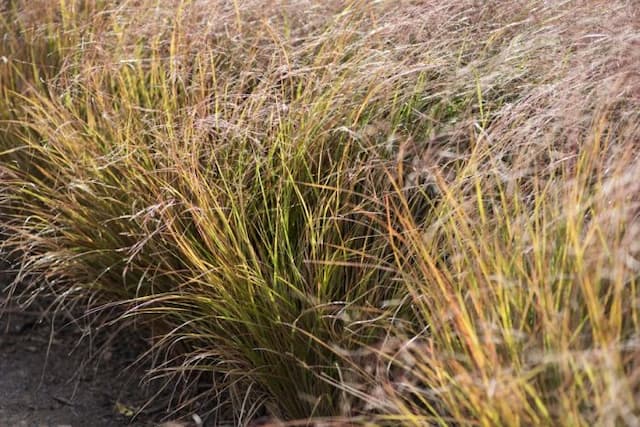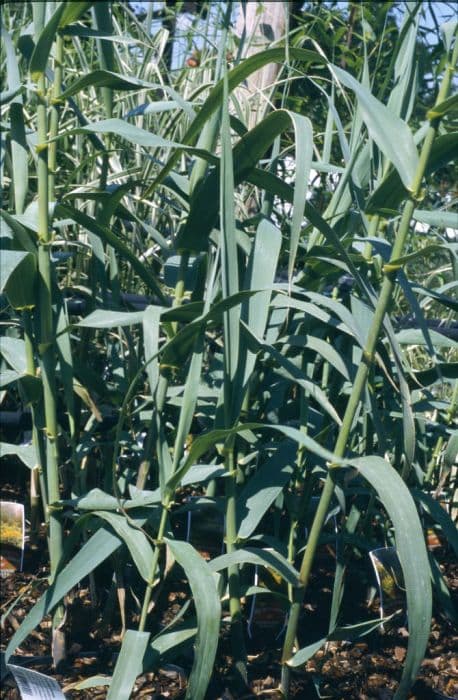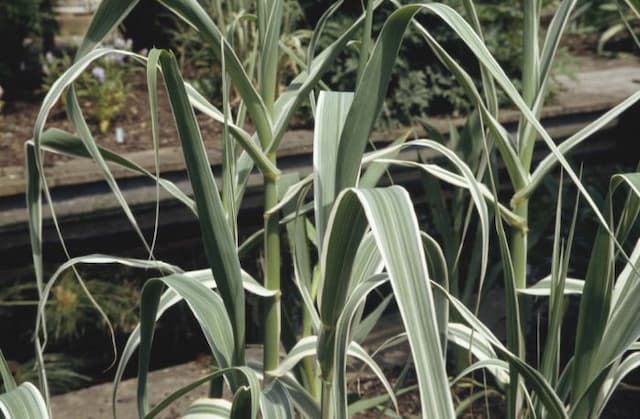Largebristle Foxtail Grass Setaria macrostachya

ABOUT
Setaria macrostachya, commonly known as golden bristle grass, is a perennial grass that exhibits a clumping growth habit. This grass typically has a dense, bushy appearance with slender, upright stems. The leaves of golden bristle grass are long, narrow, and pointed, presenting a bright green color that can bring vibrancy to a garden setting. The most distinguishing characteristic of the golden bristle grass is its inflorescences, which are the flower-bearing parts. These inflorescences are spike-like, featuring numerous small flowers tightly clustered together. They usually have a golden or yellowish hue, sometimes appearing slightly bronze, especially when catching sunlight. The texture of these spikes can be described as bristly or feathery, providing a unique tactile experience. Even when not in bloom, the foliage of golden bristle grass maintains an attractive appearance, with the leaves sometimes arching gracefully. This grass may give a soft, swaying movement in the breeze, adding a dynamic element to its surroundings. Overall, golden bristle grass is valued in landscapes and gardens for its lively color and distinctive textures that can enhance the visual interest of planting designs.
About this plant
 Names
NamesSynonyms
Large Spiked Foxtail, Giant Bristlegrass, Burro Grass, Herradura, Zorra, Cola De Zorra, Rabo De Zorra, Rabo De Burro.
Common names
Setaria pallide-fusca (Schumach.) Stapf & C.E.Hubb. ex M.B.Moss, Setaria sphacelata var. macrostachya (Kunth) T.Durand & Schinz
 Toxicity
ToxicityTo humans
The plant Setaria macrostachya, commonly known as Large bristlegrass, is not well-documented for its toxicity to humans. There is limited information available on the specific toxic compounds it may contain or the symptoms of poisoning it could potentially cause. As with any plant, individual allergic reactions or sensitivities can occur. However, without specific toxicity data, it is advised to avoid ingesting any part of the Large bristlegrass and to consult with a medical professional or a poison control center if ingestion occurs.
To pets
Similar to the information available for humans, the toxicity of Setaria macrostachya, or Large bristlegrass, to pets is not well documented. There are no specific reports of toxicity in domestic animals such as dogs and cats. Nonetheless, as general precautionary advice, pet owners should prevent their animals from ingesting this grass, since the potential effects are not fully known. If a pet does consume Large bristlegrass and shows signs of distress or illness, it is important to seek veterinary care promptly.
 Characteristics
CharacteristicsLife cycle
Perennials
Foliage type
Deciduous
Color of leaves
Green
Flower color
Varies
Height
3-4 feet (0.9-1.2 meters)
Spread
1-2 feet (0.3-0.6 meters)
Plant type
Grass
Hardiness zones
6
Native area
Mexico
Benefits
 General Benefits
General Benefits- Livestock Fodder: Setaria macrostachya, commonly known as plains bristlegrass, can be used as fodder for livestock due to its nutritive value, especially in pastoral regions.
- Soil Erosion Control: As a grass species, it helps in preventing soil erosion by stabilizing the soil with its root system.
- Wildlife Habitat: It provides a natural habitat for various species of wildlife, including birds and small mammals that may use it for shelter and nesting materials.
- Ornamental Uses: Plains bristlegrass is sometimes cultivated for its aesthetic appeal in naturalistic landscapes and prairie gardens.
- Biodiversity Enhancement: It contributes to ecosystem diversity, supporting numerous insects and other fauna that are part of the food web.
- Soil Fertility Improvement: It can aid in improving soil fertility through the decomposition of its organic matter, which enriches the soil.
- Traditional Crafts: Its stems or leaves may be used in traditional crafts, such as weaving or making thatched roofs in some cultures.
 Medical Properties
Medical Properties- Anti-inflammatory: Setaria macrostachya may possess anti-inflammatory properties, which help in reducing inflammation in the body.
- Analgesic: The plant is sometimes used for its potential analgesic effects, which can help alleviate pain.
- Antipyretic: It has been used traditionally to reduce fever, suggesting antipyretic properties.
 Air-purifying Qualities
Air-purifying QualitiesThis plant is not specifically known for air purifying qualities.
 Other Uses
Other Uses- Setaria macrostachya, commonly known as Brazilian millet, can be used in floral arrangements and bouquets, providing a unique texture with its bristly, compact seed heads.
- In crafting, the dried seed heads of Brazilian millet can be used in the creation of natural jewelry, such as necklaces and earrings, offering an organic look.
- Brazilian millet's stems are sometimes utilized in papermaking, as they provide fibrous material that can be incorporated into the paper pulp for added strength.
- The plant can serve as a bioindicator species for certain minerals in soil conservation practices, helping to monitor the health and composition of the soil.
- Landscapers may use Brazilian millet in xeriscaping, particularly in arid regions, as its drought tolerance makes it an attractive, low-maintenance option.
- As a natural dye, the pigments extracted from Brazilian millet can be employed in textile industries to color fabrics in shades of green and brown.
- In educational settings, Setaria macrostachya can be used for demonstration purposes to teach about grass biology and plant reproduction.
- Brazilian millet is sometimes planted as a cover crop to prevent soil erosion because of its fast growth and dense ground coverage.
- The dense growth habit of Brazilian millet makes it a potential privacy screen or natural barrier in landscape design.
- Bird enthusiasts may cultivate Brazilian millet in their gardens to attract and feed a variety of seed-eating birds.
Interesting Facts
 Feng Shui
Feng ShuiSetaria macrostachya, commonly known as "bur bristle grass," is not used in Feng Shui practice.
 Zodiac Sign Compitability
Zodiac Sign CompitabilityBur bristle grass is not used in astrology practice.
 Plant Symbolism
Plant Symbolism- Resilience: Scetaria macrostachya, commonly known as "bur bristlegrass," is a hardy plant that thrives in various conditions, symbolizing the ability to withstand adversity and bounce back from challenges.
- Fertility: As a grass species that produces abundant seeds, bur bristlegrass can represent fertility and the propagation of life, reflecting the idea of growth and abundance.
- Persistence: The plant's tendency to spread and take root easily is emblematic of persistence and determination, hinting at the relentless pursuit of one's goals despite obstacles.
- Freedom: Grasses like bur bristlegrass bend with the wind and move freely, symbolizing the concept of freedom and the adaptability to change without breaking.
 Water
WaterFor Large Beard Grass, also known as Setaria macrostachya, it is important to water the plant regularly to maintain consistently moist soil, especially during the growing season. Water the plant thoroughly, allowing the water to penetrate deep into the soil, which could be around 1 to 2 gallons depending on the size of your plant and the weather conditions. During the hot summer months, watering may be required once or twice a week. In cooler months or when the plant is not actively growing, reduce the frequency to every other week or when the top inch of soil feels dry to the touch. Avoid overwatering, as this can lead to root rot.
 Light
LightLarge Beard Grass prefers full sun to partial shade conditions. It thrives best when placed in a spot where it can receive at least 6 hours of direct sunlight daily. However, in extremely hot climates, some afternoon shade can be beneficial to prevent scorching. An ideal spot would be in an east or west-facing garden that gets ample morning or late afternoon sun with some protection during the peak heat of the day.
 Temperature
TemperatureLarge Beard Grass is adaptable to a wide range of temperatures but performs optimally when the temperature is between 60 and 80 degrees Fahrenheit. It can survive minimum temperatures down to about 20 degrees Fahrenheit but should be protected from frost. During hot summers, this grass can tolerate temperatures up into the high 90s as long as it is well-watered.
 Pruning
PruningPruning Large Beard Grass should be done to remove old, dead growth and encourage fresh, new foliage. Prune in late winter or early spring before the new growth starts. Trim the grass down to about 6 to 8 inches above the ground, which allows the new shoots to emerge with ease. Pruning once a year is typically sufficient.
 Cleaning
CleaningAs needed
 Soil
SoilFor Setaria macrostachya, commonly known as "Bur bristlegrass", the best soil mix is well-draining soil composed of loam or sandy loam. It should be rich in organic matter. The ideal soil pH should be slightly acidic to neutral, ranging from 5.5 to 7.0.
 Repotting
RepottingBur bristlegrass should be repotted every one to two years to refresh the soil and allow room for growth. It's typically best done in the spring or early summer.
 Humidity & Misting
Humidity & MistingBur bristlegrass prefers moderate humidity levels, around 40-60%. It can tolerate lower humidity levels but thrives with consistent moisture in the air.
 Suitable locations
Suitable locationsIndoor
Provide bright, indirect sunlight and keep at around 60% humidity.
Outdoor
Plant in full sun to partial shade in well-draining soil.
Hardiness zone
7-11 USDA
 Life cycle
Life cycleSetaria macrostachya, commonly known as the large bristlegrass, begins its life cycle when its durable seeds germinate, typically in the spring when soil temperatures increase. After germination, seedlings emerge, establishing roots and shoots to absorb nutrients and sunlight. As the plant grows, it develops tall, sturdy stems and narrow leaves, progressing into a vegetative state that precedes reproduction. Reproductive maturity is marked by the emergence of dense, bristly flower spikes, or inflorescences, which contain both male and female flower parts. Following pollination, which can occur via wind or insects, seeds develop and mature within the spikes. The plant then enters a period of senescence, eventually dying after the seeds are dispersed, which can occur through wind or by adhering to animals, and the life cycle can begin anew with the next generation of seeds.
 Propogation
PropogationPropogation time
Spring to Summer
The most popular method of propagating Setaria macrostachya, commonly known as bur bristlegrass, is through seed. Seeds should be sown in warm soil typically after the last frost date in the spring to ensure that the ground is warm enough, which is crucial for germination. The germination process usually takes 1-2 weeks. To propagate, first, prepare a well-draining soil medium in a container or in a designated area of the garden. Sow the seeds directly into the soil at a depth of approximately 1/16 to 1/8 inch (about 1.6 to 3 mm) and keep the soil consistently moist but not waterlogged. Once the seedlings are large enough to handle and have grown a set of true leaves, they can be thinned out or transplanted to their final growing positions, ensuring they are spaced apart adequately to allow for mature growth.









